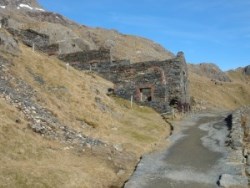
Join us on
Please visit the Sitemap to see the full range of information on this site
MountainWalk.co.uk is produced by Trish Haill Associates Copyright
Have you climbed Ben Nevis, Snowdon or Scafell Pike? Or taken part in the Three Peaks Challenge? Or have a special walk you'd like to share? We'd love to here from you! Join us on Facebook or Send us an email.
The Brittania Mine Buildings on Mount Snowdon

Old Mine Buildings by Miners Track, Snowdon
As you walk up the Miners Track evidence of mining can be seen around you.
Copper Mining on Mount Snowdon
Although there are rumours, but no confirmed evidence, that mining may have started here under the Romans, the first recorded mine here was in the early 1800's.
During the mid 18th century demand for copper began to rise, and it people though it would be worthwhile to take it out of the ground - one such use was for copper bottomed warships. But no one ever got rich taking copper from Snowdon as the costs of extracting and transporting the ore ate into any profits.
During the mid 18th century demand for copper began to rise, and it people though it would be worthwhile to take it out of the ground - one such use was for copper bottomed warships. But no one ever got rich taking copper from Snowdon as the costs of extracting and transporting the ore ate into any profits.
The mine is located at Cwn Dyli, and its ruined crushing mill can be found on the shore of Llyn Llydaw. There was a storehouse for the ore at at Pen-y-Pass, and the Pyg Track is thought to be the route the miners took the ore to the store to be dressed.
The mine was worked intermittently, but not very successfully for just over a century, and many lost large sums or money or went bankrupt despite large amounts being invested in various ventures. Although known mainly as the Great Snowdon Copper Mine or Brittainia Copper Mine, the Brittania company only owned it from 1898, but sold it to the Penypass Copper Company in 1915 - and then it closed the year later in 1916. In all seven companies tried their luck over 100 years.
Most of the buildings date from the latter half of the 19th Century - a barracks was built to house 100 men beside the lake which gives an idea of the scale the mine was worked on. Of the buildings that stand today the most obvious is the crushing mill beside Llyn Llydaw - a manager's house originally stood beside it.
Originally a men, horses and carts used to cross Llyn Llydaw by raft, but in the mid 1800s the level of lake was lowered to build a causeway across the lake. This was prompted when a raft overturned - the horse drowned and a cartload of ore sunk to the bottom of the lake. Even the causeway wasn't quite safe enough - the postman for the mine (a retired naval rating living at Pen-y-Pass was apparently blown off the causeway and drowned in a strong gale. The causeway taken by walkers is not at the original level, but was raised in 1905 when the North Wales Power Company put in sluice gates to raise the water level.
Although a lovely blue colour, there is hardly any life in the deep water as a result of contamination from the shafts and workings of the old copper mines. But if your of a romantic mind stop for a moment at look at the lake - it's also where the legendary King Arthur came across the Lady of the Lake
The mine was worked intermittently, but not very successfully for just over a century, and many lost large sums or money or went bankrupt despite large amounts being invested in various ventures. Although known mainly as the Great Snowdon Copper Mine or Brittainia Copper Mine, the Brittania company only owned it from 1898, but sold it to the Penypass Copper Company in 1915 - and then it closed the year later in 1916. In all seven companies tried their luck over 100 years.
Most of the buildings date from the latter half of the 19th Century - a barracks was built to house 100 men beside the lake which gives an idea of the scale the mine was worked on. Of the buildings that stand today the most obvious is the crushing mill beside Llyn Llydaw - a manager's house originally stood beside it.
Originally a men, horses and carts used to cross Llyn Llydaw by raft, but in the mid 1800s the level of lake was lowered to build a causeway across the lake. This was prompted when a raft overturned - the horse drowned and a cartload of ore sunk to the bottom of the lake. Even the causeway wasn't quite safe enough - the postman for the mine (a retired naval rating living at Pen-y-Pass was apparently blown off the causeway and drowned in a strong gale. The causeway taken by walkers is not at the original level, but was raised in 1905 when the North Wales Power Company put in sluice gates to raise the water level.
Although a lovely blue colour, there is hardly any life in the deep water as a result of contamination from the shafts and workings of the old copper mines. But if your of a romantic mind stop for a moment at look at the lake - it's also where the legendary King Arthur came across the Lady of the Lake
Exploring the Mine
WARNING: Remember mine exploration should not be undertaken without the right safety equipment, footwear and clothing. Old timbers are rotten and likely to snap underfoot. If you are going to explore the mine go with someone who has experience, and make sure someone knows where you are going, and what time you plan to return - a minor accident underground can have dire consequences, and it's very possible that you might get lost if your torch runs out of battery
WARNING: Remember mine exploration should not be undertaken without the right safety equipment, footwear and clothing. Old timbers are rotten and likely to snap underfoot. If you are going to explore the mine go with someone who has experience, and make sure someone knows where you are going, and what time you plan to return - a minor accident underground can have dire consequences, and it's very possible that you might get lost if your torch runs out of battery

Thanks to Craig Southwick for this picture taken from the Miners Track, October 2010
You are walking these tracks for fun, but the miners before you had another reason for walking up to the summit of Snowdon. Long before the roads were built copper ore still had to be taken from the mine to the sea - with initially no roads taking them round, miners had to carry the ore over the top of the mountain, and then use sledges to take it down the other side. If you start getting out of breath on your walk, just think about how much harder it would be to climb carrying the heavy ore with you, and spare a thought for those long ago miners!
You might also like to read Interesting Facts about Mount Snowdon
Ask at a local tourist office for details about recognised Caving Instructors/outdoor centres, who can provide basic equipment and guide you on an underground trip
Some of the 8 levels remain, together with the remains of the Britannia mill Extensive workings can be found on several levels with interconnecting stopes. Some of the upper levels are now blocked, but it is still possible to pass from the top levels through to the bottom. However, most of the woodwork has obviously seen better days, and should be regarded with great care.
The YouTube video below shows what it's like to explore inside the Brittania Mine
Some of the 8 levels remain, together with the remains of the Britannia mill Extensive workings can be found on several levels with interconnecting stopes. Some of the upper levels are now blocked, but it is still possible to pass from the top levels through to the bottom. However, most of the woodwork has obviously seen better days, and should be regarded with great care.
The YouTube video below shows what it's like to explore inside the Brittania Mine
